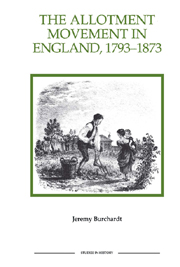Book contents
- Frontmatter
- Contents
- List of tables
- Acknowledgements
- Abbreviations
- Introduction
- PART I THE FIRST ALLOTMENT MOVEMENT
- PART II THE SECOND ALLOTMENT MOVEMENT
- PART III ALLOTMENTS AND RURAL SOCIETY
- PART IV TOWARDS THE THIRD ALLOTMENT MOVEMENT
- Conclusion
- 1 The allotments database
- 2 The origins and definition of allotments
- 3 Allotments and potato grounds
- 4 Legislative limits on plot size
- 5 Allotment plot size
- 6 Allotment rent
- 7 Animal-keeping on allotments
- 8 Allotment site rules
- Bibliography
- Index
Conclusion
Published online by Cambridge University Press: 12 September 2012
- Frontmatter
- Contents
- List of tables
- Acknowledgements
- Abbreviations
- Introduction
- PART I THE FIRST ALLOTMENT MOVEMENT
- PART II THE SECOND ALLOTMENT MOVEMENT
- PART III ALLOTMENTS AND RURAL SOCIETY
- PART IV TOWARDS THE THIRD ALLOTMENT MOVEMENT
- Conclusion
- 1 The allotments database
- 2 The origins and definition of allotments
- 3 Allotments and potato grounds
- 4 Legislative limits on plot size
- 5 Allotment plot size
- 6 Allotment rent
- 7 Animal-keeping on allotments
- 8 Allotment site rules
- Bibliography
- Index
Summary
The allotment movement came into being at the cusp of the transition from the old ‘organic’ economy of pre-industrial England to the new mineral-based economy created by the industrial revolution. Whilst, in the long run, the development of capitalism led to an across-the-board rise in living standards, in the last decade of the eighteenth and the first half of the nineteenth centuries this hung in the balance as a result of the conjunction of very rapid population growth with increased exposure to market forces. In the countryside, the check to living standards was particularly sharp, because the demand for labour grew more slowly than in the towns, whilst the proletarianising effects of enclosure intensified dependence on the labour market. Severe under-employment and a fall in wages almost to subsistence level ensued, the economic conditions in which allotments could flourish. Underemployment and the loss of common rights reduced almost to zero the opportunity cost to rural workers (especially women and children) of the time spent working on an allotment, whilst near-subsistence wages made it possible for small plots of land cultivated by spade husbandry to offer a significant increment to income.
The combination of Malthusian population crisis and proletarianisation brought rural society close to breaking point twice in the late eighteenth and early nineteenth centuries. The first occasion was the harvest failures of 1794–6 and 1799–1801, whilst the second was the Swing riots of 1830–1.
- Type
- Chapter
- Information
- The Allotment Movement in England, 1793–1873 , pp. 231 - 236Publisher: Boydell & BrewerPrint publication year: 2002



